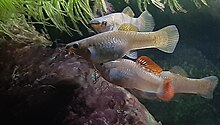
Marine angelfish are perciform fish of the family Pomacanthidae. They are found on shallow reefs in the tropical Atlantic, Indian, and mostly western Pacific Oceans. The family contains seven genera and about 86 species. They should not be confused with the freshwater angelfish, tropical cichlids of the Amazon Basin.

Gouramis, or gouramies, are a group of freshwater anabantiform fish that comprise the family Osphronemidae. The fish are native to Asia—from the Indian Subcontinent to Southeast Asia and northeasterly towards Korea. The name "gourami", of Indonesian origin, is also used for fish of the families Helostomatidae and Anabantidae.

The rosy barb is a subtropical freshwater cyprinid fish found in southern Asia from Afghanistan to Bangladesh.

Poecilia is a genus of fishes in the family Poeciliidae of the order Cyprinodontiformes. These livebearers are native to fresh, brackish and salt water in the Americas, and some species in the genus are euryhaline. A few have adapted to living in waters that contain high levels of toxic hydrogen sulfide and a population of P. mexicana lives in caves.

The sailfin molly is a livebearer fish typically found in both freshwater and brackish waterways along the East Coast of the United States, from North Carolina south to Florida, and around the Gulf of Mexico to Texas, and south to the Yucatán Peninsula of México. Given their preference for more brackish water conditions, mollies are often found within just a few yards or miles of the ocean, inhabiting coastal estuaries, lagoons, river deltas and swamps, as well as tidal areas with a regular inflow of oceanic minerals and nutrients mixing with inland freshwater sources.
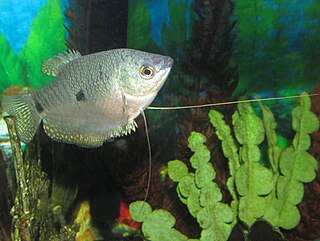
The three spot gourami, also known as the opaline gourami, blue gourami, and gold gourami, is a species of fish native to southeastern Asia, but also introduced elsewhere. This gourami gets its name from the two spots along each side of its body in line with the eye, considered the third spot. This species is of minor commercial importance as a food fish in its native range and is also farmed. It is also popular in the aquarium trade. The species reaches 15 cm in standard length.
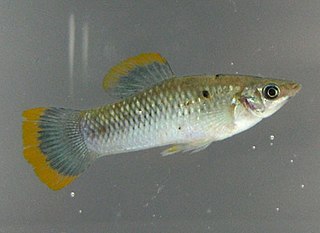
Poecilia sphenops is a species of fish, of the genus Poecilia, known under the common name molly; to distinguish it from its congeners, it is sometimes called short-finned molly or common molly. They inhabit fresh water streams, coastal brackish, and marine waters from Mexico to Colombia. The wild-type fishes are dull, silvery in color. The molly can produce fertile hybrids with many Poecilia species, most importantly the sailfin molly. The male mollies generally tend to be mildly aggressive.
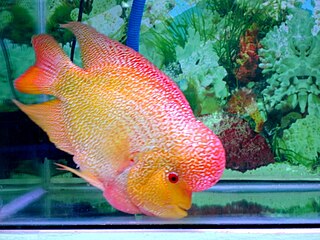
Flowerhorn cichlids are ornamental aquarium fish noted for their vivid colors and the distinctively shaped heads for which they are named. Their head protuberance is formally called a nuchal hump. Like blood parrot cichlids, they are hybrids that exist in the wild only because of their release. Flowerhorns first emerged for sale on the aquarium market in Malaysia in the late 1990s and soon became popular in many countries in Asia. They are commonly kept by hobbyists in the US, Asia, and Europe. Numerous cast-off flowerhorns have been released to the wild, especially in Singapore and Malaysia, where they have become an invasive pest animal. Their importation is banned in Australia.

The dwarf gourami is a species of gourami native to South Asia.

The ram cichlid, Mikrogeophagus ramirezi, is a species of freshwater fish endemic to the Orinoco River basin, in the savannahs of Venezuela and Colombia in South America. The species has been examined in studies on fish behaviour and is a popular aquarium fish, traded under a variety of common names, including ram, blue ram, German blue ram, Asian ram, butterfly cichlid, Ramirez's dwarf cichlid, dwarf butterfly cichlid and Ramirezi. The species is a member of the family Cichlidae and subfamily Geophaginae.

The pygmy gourami, also known as the sparkling gourami, is a freshwater species of gourami native to Southeast Asia.

Poecilia wingei, known to aquarists as Endlers or Endler's livebearer, in the genus Poecilia, is a small fish native to the Paria Peninsula in Venezuela. They are prolific breeders and often hybridize with guppies. These very colorful hybrids are the easiest to find being offered in pet-shops, typically under the name Endler's guppy.
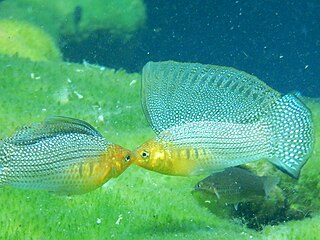
Poecilia velifera, known as the Yucatan molly and also as the giant sailfin molly amongst aquarists, is a large livebearer that lives in coastal waters of the Yucatan peninsula. These live-bearer (Poeciliidae) fish are particularly well known for both the extreme size variation among males, and the sexual dimorphism between males and females in both body shape and behavior.

The Odessa barb is a species of cyprinid fish known from Central Myanmar, where it is known to occur in an artificial pond above the Anisakan Falls and also from the lower Chindwin River. For many years it has been known to the aquarium hobby, where it has frequently been confused with the less colourful ticto barb, but it was only described scientifically in 2008.

The Cuban limia, also known as banded limia, Cuban molly, Cuban topminnow or tabai is a species of livebearing freshwater fish from the family Poeciliidae. The species is native to Cuba where it was endemic but it has been introduced to Hawaii.

Limia melanogaster, the black-bellied or blue limia, is a poeciliid fish from Jamaica. It inhabits fast-flowing streams. It is a rare livebearer in modern fishkeeping.

Poecilia kykesis, also known as the Usumacinta molly, Petén molly, spiketail molly, or swordtail molly, is a poeciliid fish species native to the fresh and brackish waters of Mexico, Guatemala, and Belize. It belongs to the sailfin molly clade, with males exhibiting an enlarged dorsal fin. The species has a notably controversial naming history, with the former name, Poecilia petenensis, now referring to a short-finned molly species. It is a livebearer sometimes kept in aquaria.

Poecilia gillii, Gill's molly, is a herbivorous livebearer fish distributed throughout Central America. It is found in both moving and still water as well as in both freshwater and brackish habitats. Populations of this species differ in color, size, and morphology.
Poecilia chica, the dwarf molly, is a livebearer fish from the Mexican state of Jalisco. The fish are small and exceptionally colorful. The dominant male may become completely black, which is a unique ability in the Mollienesia subgenus.

Poecilia orri, the mangrove molly, is a brackish-water livebearer fish from Central America. Two morphs exist, differing in size, body shape, and coloring.
